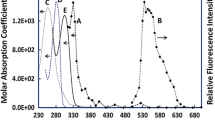Conclusions
-
1.
Using the methods of laser photolysis and CIDNP the mechanism of the photoreduction of 2,6-diphenyl-1,4-benzoquinone by diphenylamine has been established and the kinetics and spectral characteristics of the short-lived intermediate products formed during the photo-reduction process have been determined.
-
2.
Quenching of triplet 2,6-diphenyl-1,4-benzoquinone by diphenylamine occurs by an electron and H-atom transfer mechanism, both processes taking place in an encounter complex and being concurrent with one another.
-
3.
The nature of the short-lived intermediate products formed during quenching of the triplet 2,6-diphenyl-1,4-benzoquinone by aromatic amines in a weakly polar medium has been established. When quenching with diphenylamine a nondissociated ion-radical pair is formed, but with triphenylamine a triplet exciplex is formed.
-
4.
The predominant role of the triplet mechanism in giving rise to CIDNP in ion-radical reactions which occur in weakly polar media has been confirmed.
Similar content being viewed by others
Literature cited
S. Arimitsu, H. Masuhara, N. Mataga, and H. Tsubomura, J. Phys. Chem.,79, 1255 (1975).
R. Scheerer and M. Grätzel, J. Am. Chem. Soc.,99, 865 (1977).
V. A. Kuzmin, A. P. Darmanyan, and P. P. Levin, Chem. Phys. Lett.,63, 509 (1979).
H. D. Roth, Chemically Induced Magnetic Polarisation (ed. by L. T. Muus, P. W. Atkins, K. A. McLauchlan, and J. B. Pedersen), D. Reidel Publishing Co., Dordrecht, Holland (1977), Chap. IV, p. 53.
V. M. Kuznets, P. P. Levin, I. V. Khudyakov, and V.A. Kuz'min, Izv. Akad. Nauk SSSR, Ser. Khim., 1284 (1978).
S. K. Wong, J. Am. Chem. Soc.,100, 5488 (1978).
A. P. Darmanyan and V. A. Kuz'min, Dokl. Akad. Nauk SSSR,227, 1139 (1976).
T. Shida and A. Kira, J. Phys. Chem.,73, 4315 (1969).
R. Kaptein, Chem. Commun., 732 (1971).
A. L. Buchachenko and A. M. Vasserman, Stable Radicals [in Russian], Khimiya (1973), pp. 146, 207.
V. M. Kuznets, D. N. Shigorin, and A. L. Buchachenko, Dokl. Akad. Nauk SSSR,253, No. 2 (1980).
J. K. S. Wan and A. J. Eliot, Acc. Chem. Res.,10, 161 (1977).
K. H. Hauser and D. Stehlik, Adv. Magn. Res.,3, 79 (1968).
Author information
Authors and Affiliations
Additional information
Translated from Izvestiya Akademii Nauk SSSR, Seriya Khimicheskaya, No. 12, pp. 2744–2750, December, 1980.
Rights and permissions
About this article
Cite this article
Levin, P.P., Darmanyan, A.P., Kuz'min, V.A. et al. Investigation of the mechanism of electron and hydrogen-atom transfer during quenching of the triplet state of 2,6-diphenyl-1,4-benzoquinone by aromatic amines using the methods of laser photolysis and CIDNP. Russ Chem Bull 29, 1919–1924 (1980). https://doi.org/10.1007/BF00949657
Received:
Issue Date:
DOI: https://doi.org/10.1007/BF00949657




